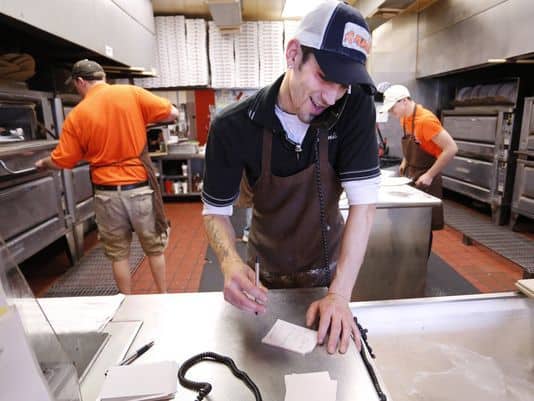
LAFAYETTE, Ind. — Not everyone has time to sit down and eat at a restaurant. Maybe they just want to have a few moments to themselves with a meal already prepared.
Several local restaurants offer food to go, but what should people do about to-go tipping? Sure, you’re getting the same food, but the service is a different experience.
A Florida server complained on social media about how she wasn’t tipped on a 75-item order, which totaled about $700, last month. According to the Palm Treasure Post, she spent most of her shift preparing the order.
So what’s the protocol for to-go orders? What do local restaurants expect?
For Arni’s manager Connie Moorehouse, it depends on the situation.
My personal take on it is you shouldn’t have to tip for carry-out,” Moorehouse said.
But it depends on from whom you’re ordering.
If you’re ordering to-go from a server, absolutely you should tip them, Moorehouse said.
Servers make less than minimum wage — usually around $2.50 an hour, if not less — and they have to pay taxes on their tips, sometimes even if they don’t get a tip.
“They say, ‘Well, you should pay your employees more,'” Moorehouse said. “Well, if we pay our employees more, then they’ll have to pay more for their food, more this and that.”
Moorehouse said their servers pay 8 percent tax on every order they ring up.
But if you call Arni’s and pick up a pizza, Moorehouse said, it’s not mandatory nor is it expected that you tip that person ringing you up.
People who work the pick-up counter, she said, usually make at least minimum wage.
Staff members outside of servers don’t rely on tips as part of their income. But that’s not to say you can’t tip them.
“If that person goes out of their way to do something for you … and you want to reward them in that way, I think that’s great,” Moorehouse said. “But just to say ‘I automatically tip (on to-go order)’ — nuh uh, no.”
Some restaurants, usually chains, offer curbside service. Moorehouse said since they’re bringing it out to you or if they deliver, then tipping is expected.
It’s not a bad habit to tip based on your service, especially when you sit down to eat, but not everyone is a fan of tipping in general, she said.
The normal tipping amount has increased. She said a good-service tip is between 25 to 28 percent.
Sgt. Prestons manager Rich Micky said when they get to-go orders, only about 30 to 40 percent of those customers tip. And his staff doesn’t really expect people to tip for to-go orders.
At Sgt. Prestons, the cooks and the servers may be the ones to box up your order, depending on how busy everyone is, Micky said.
For larger orders that may include a larger tip, it’s split up between everyone who handles, he said.
But should people tip to-go orders?
“It’s hard to say,” he said.
How much to tip and for what?
But there’s still a lot of confusion on the topic, including how much to tip, which services deserve one and how taxes come into play. Here are some suggestions:
What’s standard?
In theory, anything goes with tipping. If you’re satisfied with the service, you can leave as much as you want — or nothing if you feel shortchanged. But in reality, most of us look over our shoulders, wondering what the guy at the next table is paying.
According to a survey by CreditCards.com, which elicited more than 1,000 responses in June, four in five restaurant customers said they always leave a tip, at 18 percent on average. That’s a median or midpoint amount, meaning half the respondents leave more than 18 percent and half, less. Somewhere between 15 percent and 20 percent appears to be the standard range.
Whether you should tip on the total bill or just the pre-tax amount is a debatable and unresolved point, though pre-tax seems more logical. It doesn’t make sense that a waitress server in Louisiana should make almost 10% more than another in Oregon just because sales-tax differentials between the two states are roughly that wide.
Forms of payment
One interesting finding from the CreditCards.com study was that customers using credit or debit cards were significantly more likely to tip than people paying with cash. This reflects a tendency that researchers have noted for years — many people often don’t view purchases made with plastic the same way they view cash transactions.
“When you pay with a card, your brain doesn’t see it as real money, so it’s not as painful,” Michael McCall, a Michigan State University professor, told CreditCards.com.
But there also might be an anonymity factor at work here. If you don’t want to leave a big tip, you can plunk down some currency or coins, then scramble for the exit without disclosing your name.
Which services are covered?
Americans commonly tip for certain types of assistance but not others. Some examples cited in the CreditCards.com survey: 67 percent of respondents said they always tip barbers/hair stylists, 29% always tip baristas at coffee shops and 27% always leave money for the housekeeping staff at hotels.
The Emily Post Institute offers various general suggestions, including 15 percent to 20 percent at sit-down restaurants, 10 percent for buffets and 10 percent to 15 percent for home food delivery ($2 to $5 for pizzas). Other suggestions: $2 to $5 a night for hotel maid staff (with a note marked for housekeeping), 15 percent to 20 percent for taxi drivers (plus $1 to $2 for bags carried), $2 to $5 when a valet returns your vehicle and 15 percent to 20 percent at hair salons.
Contributing to tip jars on counters isn’t obligatory, according to the etiquette company.
